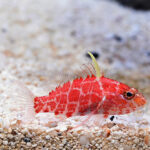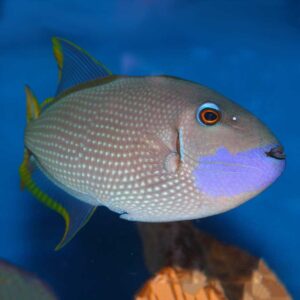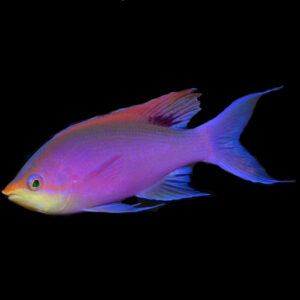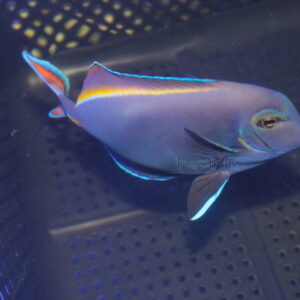Description
The Tiger Jawfish, scientifically known as Opistognathus randalli, is a visually stunning fish with captivating features. It has a maximum size of around 4 inches (10 centimetres), making it relatively small in the marine world. This species exhibits a unique pattern of black and orange stripes, resembling the markings of a tiger, hence its common name.
Taxonomy
The Tiger Jawfish belongs to the genus Opistognathus and is a member of the family Opistognathidae. Within its genus, it shares identifying features such as a protruding lower jaw and a slender body. The closest relatives of the Tiger Jawfish include other jawfish species found in similar marine environments.
Natural Habitat
In its natural habitat, the Tiger Jawfish inhabits sandy coastal areas and coral reefs. Its surroundings are often characterized by a mix of sandy patches and scattered coral formations. These areas provide ample hiding spots and shelter for the jawfish, as it prefers to construct and reside within its burrow.
Keeping Tiger Jawfish Healthy:
The care level for Tiger Jawfish is considered moderate, requiring attention to ensure their well-being. They thrive in a marine aquarium with stable water parameters, including a temperature range of 75-80°F (24-27°C) and a pH level between 8.1 and 8.4. Maintaining appropriate salinity levels around 1.025 specific gravity is crucial for their health. Regular water changes and efficient filtration are essential to maintain water quality.
Special Requirements and Feeding
Tiger Jawfish have specific requirements to promote their overall health and vitality. They prefer a sandy substrate in the aquarium to enable their natural burrowing behaviour. Providing suitable hiding places, such as a coconut shell or blenny home, allows the jawfish to feel secure and reduce stress.
Feeding the Tiger Jawfish is relatively straightforward, as they readily accept a diet consisting of small meaty foods. Offer a variety of live or frozen foods, including brine shrimp, mysis shrimp, and small pieces of fish or shrimp. Providing a balanced diet rich in nutrients helps to ensure their optimal growth and vibrant colouration.
How Many Should I Keep?
When considering the number of Tiger Jawfish to keep, it is essential to provide each fish with sufficient space and territory. Due to their territorial nature, it is advisable to house only one jawfish per tank, unless in a large and well-established aquarium with ample hiding spots.
Behaviour
Tiger Jawfish are full of charisma and fascinating to observe as they interact with their environment. They spend a significant amount of time near their burrow, often popping in and out to survey their surroundings like a grumpy old man fussing about his lawn. Providing a suitable burrowing substrate and additional hiding places mimics their natural behaviour and creates a comfortable habitat.
Lighting Preference
Tiger Jawfish thrives under moderate to high lighting conditions. Adequate lighting enhances their vibrant colouration and overall visual appeal. Providing a combination of natural daylight and appropriate aquarium lighting fixtures supports their well-being.
Suitable Tank Mates
When selecting tank mates for Tiger Jawfish, compatibility is crucial. Avoid aggressive or larger fish that may intimidate or harm the jawfish. Suitable companions can include peaceful reef fish, and other non-aggressive species that inhabit different levels of the aquarium.
Reproduction in the Wild
Tiger Jawfish, scientifically known as Opistognathus randalli, exhibit interesting reproductive behaviours in the wild. They are known to be monogamous, forming pair bonds during the breeding season. This species follows an egg-guarding reproductive strategy, where the male assumes the primary responsibility of caring for the eggs.
Breeding Opistognathus randalli
- Set Up:
To successfully breed Tiger Jawfish in captivity, a well-maintained marine aquarium with appropriate conditions is necessary. The tank should have a sandy substrate and ample hiding spots, such as small caves or PVC pipes, to mimic the jawfish’s natural burrowing behaviour. The water temperature should be maintained between 75-80°F (24-27°C), and the pH level should range from 8.1 to 8.4.
- Courtship/Spawning:
Courtship behaviour in Tiger Jawfish involves a series of intricate movements and displays. The male jawfish initiates the courtship by performing a “headstand” display, where it positions its body vertically and vibrates. This behaviour signals its readiness to breed. The female responds by performing a circular dance around the male, showing her acceptance.
Once courtship is successful, spawning occurs. The female releases a cloud of eggs while the male simultaneously releases sperm to fertilize them. The male quickly collects the fertilized eggs in his mouth and carries them inside his buccal cavity for incubation and protection.
- Rearing:
The male diligently guards the eggs, not eating during this period, which typically lasts around 7-10 days. He periodically opens his mouth to aerate the eggs and remove any debris. Once the eggs hatch, tiny larvae emerge, resembling miniature transparent versions of the adults. At this point, the larvae become pelagic, drifting in the water column before eventually settling to the substrate.
Sexual Dimorphism
Tiger Jawfish do not exhibit significant sexual dimorphism, meaning the physical differences between males and females are minimal.
Distribution
The Tiger Jawfish, Opistognathus randalli, is naturally distributed in the Indo-Pacific region, particularly in the waters off Indonesia and the Philippines. While captive-bred and line-bred strains may be available, the original fish originate from this region.
Summary
The Tiger Jawfish, Opistognathus randalli, is a visually striking marine species known for its vibrant striped pattern resembling a tiger. This species follows a monogamous breeding behaviour and practices egg-guarding, with the male taking on the responsibility of incubating and protecting the eggs. Breeding Tiger Jawfish in captivity requires a well-maintained marine aquarium with appropriate conditions. During courtship, the male performs a distinctive headstand display, and spawning occurs when the female releases a cloud of eggs. The male collects and incubates the fertilized eggs in his mouth until they hatch. Tiger Jawfish are naturally distributed in the Indo-Pacific region, specifically in the waters off Indonesia and the Philippines. While captive-bred and line-bred strains may be available, the original fish originate from this region.
The Fish pictured here are representative only and the livestock you receive may vary in pattern, coloration, and shape.









 Achilles Hybrid Tang
Achilles Hybrid Tang
Reviews
There are no reviews yet.